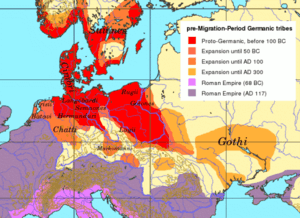East Germanic tribes
.png)
The Germanic tribes referred to as East Germanic constitute a wave of migrants who may have moved from Scandinavia into the area between the Oder and Vistula rivers between the years 600 and 300 BC. Later they went to the south. Unlike the Northern and Western tribes, they did not successfully preserve their ethnicity and were primarily assimilated into West Germanic tribes and Romans.
According to some theories, the east Germanic tribes, related to the North Germanic tribes, had migrated from Scandinavia into the region east of the Elbe River (Vandals, Burgundians, Goths, Rugians and others).[1]
Groups
Groups identified as East Germanic tribes include:
Traditionally the Lombards were classified as East Germanic, however, the Lombardic language is now considered by many specialists to be close to Old High German, especially its Upper German dialects, which would make a classification as West rather than East Germanic more sensible.

Language
The East Germanic languages are contrasted with North and West Germanic. However, the East Germanic languages shared many characteristics with North Germanic, perhaps because of the later migration date.
All the East Germanic languages are extinct as living languages. However, there have been recent attempts by Germanic tribal polytheists to reconstruct a form of neo-Gothic as a common community language. This is primarily based on the academic publications of a small number of scholars who have studied what remains of the written records of the Gothic dialects within Italia, the Iberian peninsula, and old Anatolia.
See also
Notes and references
- ↑ The Penguin atlas of world history / Hermann Kinder and Werner Hilgemann ; translated by Ernest A. Menze ; with maps designed by Harald and Ruth Bukor. Harmondsworth : Penguin Books. ISBN 0-14-051054-0, 1988, Volume 1. p.109.